How-to content is among those gaining the most engagement and links.
No wonder:
It’s evergreen, actionable, and valuable. It teaches problem-solving to the audience. Given its topics’ relevancy, authors can refine and update it regularly to breathe new life into it and make it work again.
The category of how-to content includes guides, instructional videos, tutorials, and articles that help the audience solve a particular problem.
What makes an efficient guide? Why is this content type critical for your marketing strategy? How to write the one that brings traffic and turns readers into clients?
In this blog post, you’ll get the answers.
What makes an efficient guide?
In plain English, a guide is a tutorial on accomplishing something. It’s an instructional document detailing a process from beginning to end, step by step. When done right, guides keep users back because they are accessible and easy to accomplish.
The features of an efficient guide:
- A straightforward structure
- Step-by-step instructions
- A specific result (a completed task) users get after following the instructions
What’s in how-to guides for you, a content creator or a marketer?
- Search intent. One of the top reasons users come to Google or other search engines is to get instructions on how to do something. The “how to” queries is your way to satisfying users’ search intent with relevant, informative content they want to see.
- Higher rankings, more traffic. The more relevant your guide is to what users search, the higher Google ranks it in SERPs. As a result, more users see and click on it, bringing more traffic to your website.
- Brand authority and trust. How-to guides help you distribute knowledge and showcase expertise in your niche. By providing users with relevant, actionable, and valuable information, you earn their trust and motivation to choose your brand over others.
5 steps to writing how-to guides that bring traffic and clients
And now, to practice:
While how-to article writing seems fast and easy, writing a guide that will bring results is not that simple. The below five steps can help reveal the how-to guide’s nature better.
Step 1: Find a problem to solve in your content
It will depend on the target audience you plan to engage with your guide. What is their knowledge level? While most people seeking out how-to guides are newbies to the topic, how-to’s for beginners and experienced users have different specifics.
The main criterion of choosing a relevant topic for your guide is its value to the target audience.
How to find such a topic and ensure it’ll skyrocket?
- Take your target keyword and examine corresponding search queries: What do people ask about this topic?
- Go to online forums like Quora and check user-generated responses related to your target keyword: What are common themes, confusions, and misconceptions around it?
- Ask your customer support team: What are the most frequent questions they get from clients?
- Consider the pain points of your ideal customer: Address your detailed buyer persona for that.
- Analyze the competitors: What is the top content on their blogs? Which topics bring them the most traffic and shares?
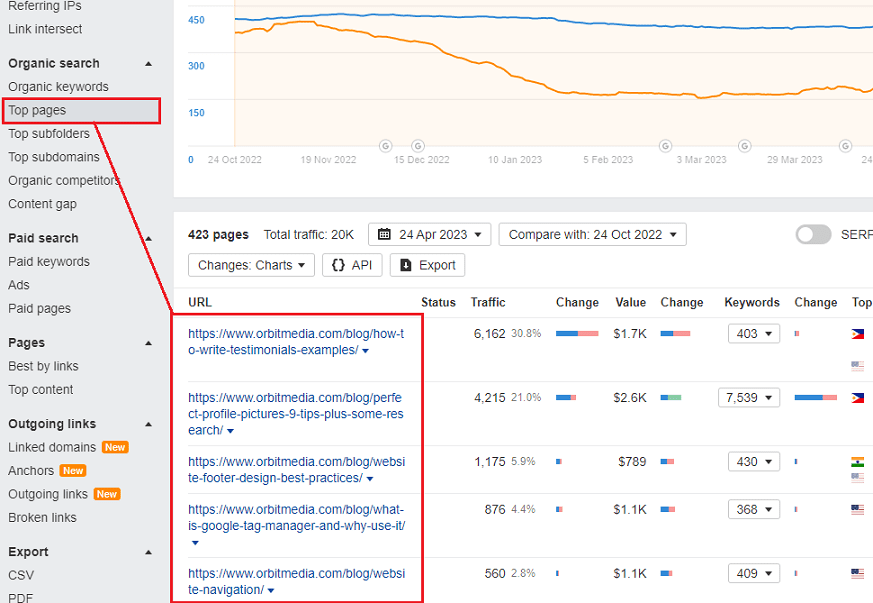
Once you have a topic, decide on the most convenient content type to cover it.
Will it be a short how-to blog post or 3,000+ words long read? Would you format it as a straightforward checklist or write an ebook? Video how-to guides call the shots now, so why not think of organizing actionable how-to playlists on your YouTube channel?
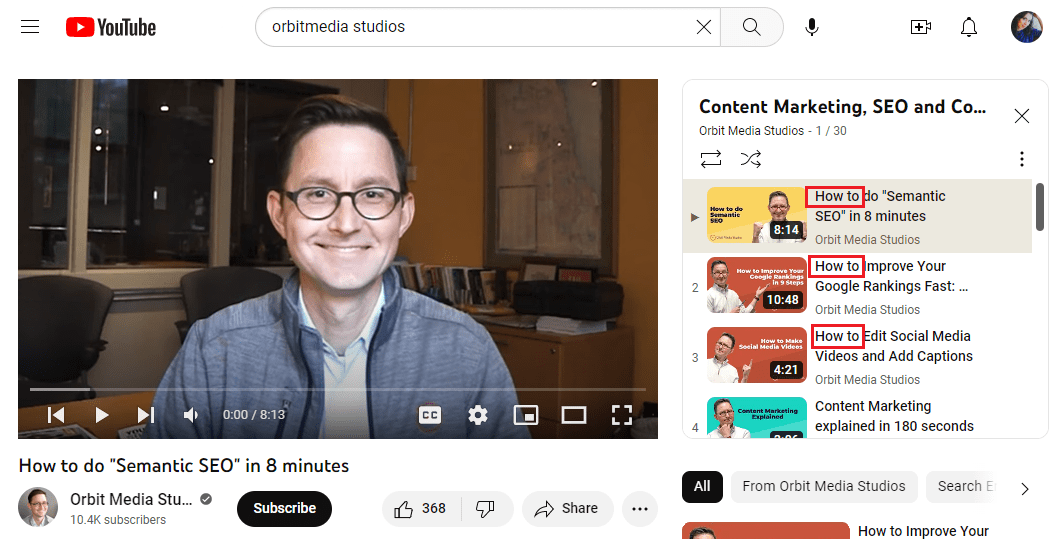
Step 2: Create a detailed outline
Now that you have a topic and a format for your guide, it’s time to create an outline and ensure it will be comprehensive.
Research the topic so you don’t miss any step or detail.
Here’s the catch: It’s more challenging to write how-to guides when you know the topic well. You start making assumptions about what to include, what to cover as the first step, etc.
So, even if you’re an expert in the niche, knowing the topic inside out, do your best to think of it from a reader’s perspective. Come up with the complete list of steps for your guide, and remember to fact-check sources so your final content piece will be trustworthy.
Efficient guides should have a straightforward structure with step-by-step instructions. With that in mind, organize all the steps into logical and consistent order:
- Ensure you don’t skip or mix up the steps.
- Consider the logic behind the sequence of steps.
- Follow your basic writing skills, and use actionable words and concise language. Remember the target reader and their knowledge level of the topic.
The more logical the guide’s structure, the easier it is to perceive and process. To save time, you might ask AI writing tools for help with steps for your guide. They’ll provide general ideas, and you’ll organize them into the guide’s detailed plan later.
How to outline a comprehensive guide
Craft a two-column table, where the first column will be for steps and the second one — for a brief description of what will be there.
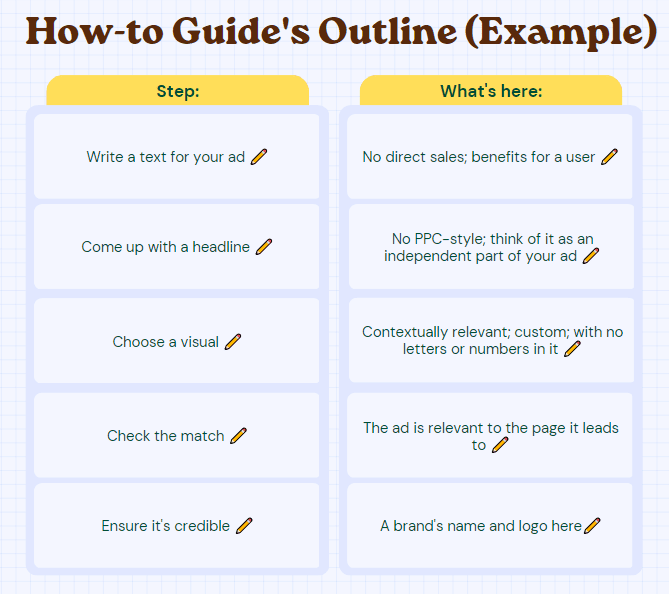
Step 3: Be super specific about each step
Each step of your how-to guide will be a separate content block with a subhead and a straightforward structure. Follow the scheme:
- Beginning: Why a user needs this step; the required equipment.
- Middle: The process itself; what to do and how to do it to achieve the subhead’s goal.
- End: The result; what a user gets after taking the step.
When writing, consider the below tips:
Make your guide’s introduction as short as possible. We know online users don’t read but scan content to decide if it’s worth reading; most go to tables of content or scroll to see subheads at once. Given that, keep intros up-to-point and format them for better readability and engagement:
- Use short paragraphs and sentences.
- Hook from the very first sentence.
- Consider highlights to grab attention (bold, italics, lists, etc.)
Follow the example of Brian Dean from Backlinko. He’s the master of writing engaging yet informative intros for the guides he shares.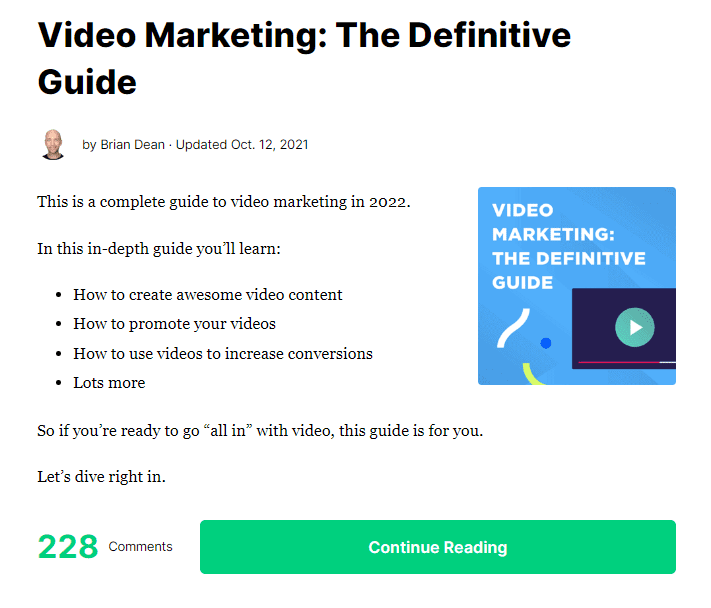
Avoid passive voice. Guides are about actionable steps taken for a desired result, so active verbs telling people what to do are your writing tactic here. (Have you noticed the format of this article’s subheads, by the way?)
Be specific when describing the steps: “Take a pen” sounds more convincing and confident than “It would help if you took a pen.”
Be concise. Don’t overcomplicate the steps you describe in the guide. Avoid slang, professional jargon, too complex sentences, long paragraphs, etc. Be as specific as possible; say no to sophisticated terms and other patterns users might get wrong.
The same is true about the temptation to include too general information and excessive details in your guide. Make it as concise and up-to-point as possible.
Place only the information that will help put a step into practice. Nothing more.
Step 4: Add visuals. As many as you can
Everyone who crafts online content or learns blogging knows the role of visuals. When it comes to how-to guides, tutorials, or any other educational content asset, this role turns out to be even more essential:
Illustrations, photos, screenshots, GIFs, and other visual elements supplement your instructions and help users understand your guide better. Use everything that helps “visualize” the process.
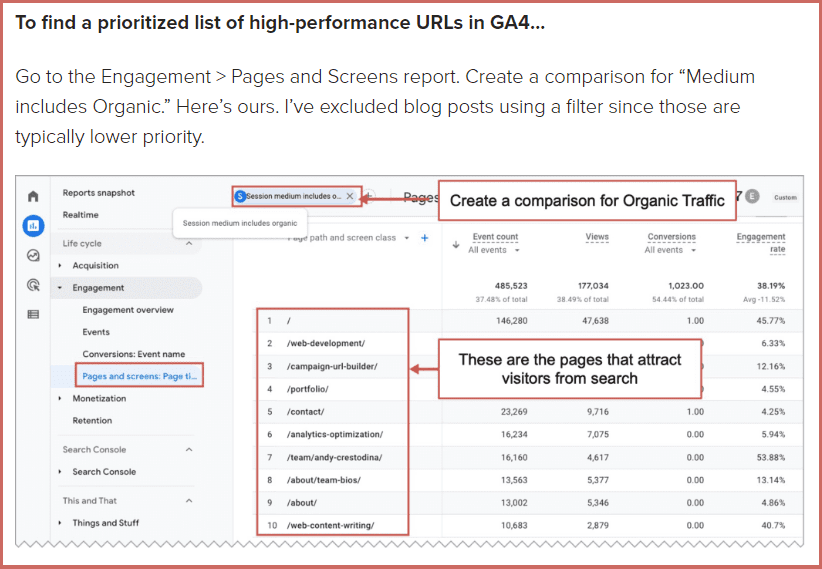
Plus, consider examples:
Remember they are an element of storytelling; the human brain retains 70% of information through stories. Most people are visual learners, so the more you can illustrate through your guide, the better.
If the article is difficult to illustrate and the steps appear text-heavy, use blocks, quotes, color- or font highlights, and any other visual elements influencing its readability.
“Formatting is critical for online content, but it’s double critical for how-to guides: You need to grab and hold the reader’s attention so they become immersed in the process. That’s why when we see something’s wrong with our blog’s technical part, we’ll audit its usability. It helps to understand what to fix so that readers feel more comfortable and come back.”
— Addys Mayers, Designer, EasyEssay blog
Also, remember to link to other relevant and trustworthy resources throughout your guide: Not only will it help readers find and learn more information on the topic, but it’s also your instrument for building authority and trust with your audience.
Step 5: Revise and edit with no mercy
So now you have it, a complete draft of your how-to guide. The last step is re-reading it a few times to ensure it meets your reader’s expectations and needs and edit it accordingly (if necessary).
Answer the question, “Why does the audience need it or want to know this?”
Understanding the purpose behind your guide will help you write better, be more empathetic and specific about how you describe the steps, and create content your readers need.
What to check when editing your guide:
- Does it meet the knowledge level of its target audience?
- Is it actionable? (How-to guides are about practical steps and concrete results, not lengthy reflections. They are calls to action: read it and do it.)
- Are all the steps logical and consequent? Have you missed anything?
- Aren’t there too lengthy descriptions that you could break into several separate steps?
- Haven’t you considered any challenges or pitfalls a reader can face when taking the steps?
- Is it clear from the article when the step is applicable and when it is not?
- Is the language clear and straightforward? Will the audience be able to use the guide in practice?
Don’t be afraid of editing and rewriting your guide if necessary. As Hemingway said, “The first draft of anything is sh*t.” Revising guides is okay until they are detailed and clear enough to meet the audience’s needs.
Your guide will bring traffic and conversion only if it showcases expertise. For that, ensure its author is an expert in the niche, shares the personal experience, or creates the content collaborating with experts who shared insights and comments for this guide.
As far as we know, Google’s emphasis is on E-E-A-T, not E-A-T now.
Takeaways
Content marketing campaigns need how-to guides and other informative content to build brand awareness, loyalty, and trust and help target consumers step to the next stage — turning into clients.
When done right, guides serve both the brand and the customer. While you get credibility and engagement, your client gets valuable knowledge to put into practice.




